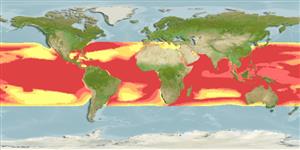Elasmobranchii (Haie und Rochen) (sharks and rays) >
Carcharhiniformes (Ground sharks) >
Sphyrnidae (Hammerhead, bonnethead, or scoophead sharks)
Etymology: Sphyrna: Probable misspelling of sphyra (Gr.), hammer, referring to their hammer-shaped heads. (See ETYFish); mokarran: Arabic vernacular for this shark, described from the Red Sea, possibly from mogharn, horned, referring to the shape of its head. (See ETYFish).
More on author: Rüppell.
Environment: milieu / climate zone / depth range / distribution range
Ökologie
seewasser; brackwasser; ozeanodrom (Ref. 51243); tiefenbereich 1 - 300 m (Ref. 37816), usually 1 - 100 m (Ref. 89972). Subtropical; 40°N - 37°S, 180°W - 180°E
Circumglobal in coastal warm temperate and tropical seas (Ref. 13562). Western Atlantic: North Carolina, USA to Uruguay, including the Gulf of Mexico and Caribbean. Eastern Atlantic: Mediterranean and Morocco to Senegal. Indo-Pacific: throughout the Indian Ocean; Ryukyu Islands to New Caledonia and French Polynesia. Eastern Pacific: southern Baja California, Mexico to Peru. Highly migratory species.
Length at first maturity / Size / Gewicht / Alter
Maturity: Lm 249.5, range 210 - 300 cm
Max length : 610 cm TL Männchen/unbestimmt; (Ref. 244); common length : 370 cm TL Männchen/unbestimmt; (Ref. 13562); max. veröff. Gewicht: 449.5 kg (Ref. 40637); max. veröff. Alter: 30 Jahre (Ref. 116211)
Rückenflossenstacheln (insgesamt): 0; Rückenflossenweichstrahlen (insgesamt): 0; Afterflossenstacheln 0; Afterflossenweichstrahlen: 0. A very large hammerhead also with a notch at the center of the head (Ref. 5578). Front margin of head gently curved in juveniles, becoming nearly straight in adults, with slight median notch (Ref. 26938). 1st dorsal fin very high and curved; 2nd dorsal and pelvic fins high and with deeply concave rear margins. Light grey or grey-brown above, white below; fins without conspicuous markings (Ref. 5578).
A coastal-pelagic, semi-oceanic shark, found close inshore and well offshore, over the continental shelves, island terraces, and in passes and lagoons (Ref. 244, 58302). Often bottom and reef associated at 1-80 m (Ref. 58302). Prefers to feed on stingrays and other batoids, groupers and sea catfishes, but also preys on other small bony fishes, crabs, squid, other sharks, rays, and lobsters (Ref. 244, 13562, 1602). A viviparous species, with 13-42 of about 56 to 70 cm young in a litter (Ref. 26938, 1602). Potentially dangerous to people (Ref. 13562) but only few, if any, of the attacks on people can be definitely attributed to it because of the apparent difficulty of distinguishing large hammerhead species involved in attacks (Ref. 244). Caught occasionally by target shark longline, demersal tangle net and tuna gillnet fisheries (Ref.58048). Meat utilized for human consumption (fresh, fresh-frozen, dried-salted, and smoked), liver oil for vitamins, fins for soup, hides for leather, and carcasses for fishmeal (Ref. 244). Its large fins, including the tail, sail-like first dorsal fin, are prized in the Oriental sharkfin trade (Ref. 47737).
Viviparous with a yolk sac placenta and 13-42 young in a litter (Ref. 244); 6-42 pups after gestation period of ~11 months (Ref.58048). Size at birth between 50 to 70 cm TL (Ref.58048, Ref. 13562).
Compagno, L.J.V., 1984. FAO Species Catalogue. Vol. 4. Sharks of the world. An annotated and illustrated catalogue of shark species known to date. Part 2 - Carcharhiniformes. FAO Fish. Synop. 125(4/2):251-655. Rome: FAO. (Ref. 244)
IUCN Rote Liste Status (Ref. 130435)
Nutzung durch Menschen
Fischereien: kommerziell
Mehr Information
ReferenzenAquakulturAquakultur ProfilZuchtlinienGenetikElectrophoresesVererbbarkeitKrankheitenVerarbeitungNutrientsMass conversion
Tools
Zusatzinformationen
Download XML
Internet Quellen
Estimates based on models
Preferred temperature (Ref.
123201): 21.3 - 28.9, mean 27.2 °C (based on 4410 cells).
Phylogenetic diversity index (Ref.
82804): PD
50 = 0.5029 [Uniqueness, from 0.5 = low to 2.0 = high].
Bayesian length-weight: a=0.00229 (0.00133 - 0.00396), b=3.10 (2.94 - 3.26), in cm total length, based on LWR estimates for this species & (Sub)family-body (Ref.
93245).
Trophic level (Ref.
69278): 4.3 ±0.5 se; based on diet studies.
Widerstandsfähigkeit (Ref.
120179): niedrig, Verdopplung der Population dauert 4,5 - 14 Jahre. (tmax=30; tm=8.2; Fec=13).
Fishing Vulnerability (Ref.
59153): Very high vulnerability (90 of 100).
Nutrients (Ref.
124155): Calcium = 6.09 [1.31, 34.08] mg/100g; Iron = 0.597 [0.148, 1.835] mg/100g; Protein = 20.7 [18.6, 22.9] %; Omega3 = 0.168 [0.066, 0.417] g/100g; Selenium = 33.5 [10.8, 93.8] μg/100g; VitaminA = 4.93 [1.58, 16.43] μg/100g; Zinc = 0.393 [0.195, 0.737] mg/100g (wet weight);
